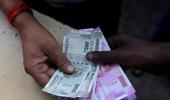Overall, small savings have amassed Rs 1.17 trillion from April-September — 26 per cent more than the previous year. But in those six months, the economy lost 24 per cent in the first three months, and is slated to lose 10 per cent in the second quarter.

Indians pumped nearly Rs 1 trillion into small savings schemes during the first six months of the fiscal year (2020-21, or FY21) even as the Covid-19 pandemic upended normal life.
This is the highest-ever contribution in savings deposits and certificates — essentially the investment instruments targeted at farmers, senior citizens, the girl child, salaried class, and labourers — in a period of six months, underlining how their role as the piggy bank for the lower middle class is changing rapidly.
The amount collected in the first half was 25 per cent more than last year, and 130 per cent more than the average of the past five years.
This includes the National Savings Certificate, Kisan Vikas Patra (farmer development certificate), Sukanya Samriddhi Yojana (scheme for the prosperity of the girl child), Senior Citizens Savings Scheme, and deposits in the post office: be it savings, term or recurring deposits.
The money in Public Provident Fund (PPF), largely held by the salaried class, was also a record, kissing the Rs 20,000-crore mark — 46 per cent more than the April-September average of the past five years.
Overall, small savings have amassed Rs 1.17 trillion from April-September — 26 per cent more than the previous year.
But in those six months, the economy lost 24 per cent in the first three months, and is slated to lose 10 per cent in the second quarter.
A government official who overlooks the small savings administration said the affluent are increasingly accessing small savings now.
“It is being observed that the relatively richer are parking money in these savings.
"It has become more broad-based than its original avatar,” he said.
Banks are the nodal points for enrolling into these schemes, and that is facilitating inflows, he added.
Another official said that a cursory analysis of PPF shows that most of the contributions are coming from high per capita income urban areas.
D K Joshi, chief economist at CRISIL, said this is the usual behaviour in risky times.
“The data reflects the proclivity to save as a precaution. Savings in most countries go up during such times,” he said.
The massive jump in collection by small savings instruments assumes greater significance if we look at bank deposits during this period, especially demand deposits which broadly represent the savings deposit accounts.
The period under consideration is from the middle of April till the end of September since the March-end data for deposits distorts the numbers.
Small savings have been offering a healthy premium of about 40 basis points (bps) for a one-year term deposit, and more than 250 bps over the bank savings deposit, in times of pandemic.
The spread was higher in 2019.
For two years on the trot, small savings inflow has been more than the incremental savings bank deposits.
In April-September of 2019-20 (FY20), bank demand deposits accretion was very low at Rs 40,000 crore from mid-April to end-September.
Small savings collection was Rs 93,000 crore.
This year, in the same period, citizens have deposited Rs 1 trillion, and small savings collections have touched Rs 1.2 trillion.
This is a sharp departure from the earlier trend.
In the past few years, incremental savings bank deposits have been 2-5x the collection in small savings in the first half of the fiscal year.
Time deposits or fixed deposits, on the other hand, have seen an accretion of Rs 4.5 trillion in April-September, substantially higher than the past three years’ average.
This could mean that while people are preferring small savings instruments over savings bank deposits, money flow into banks through long-term deposits has also bulged considerably, further showing risk-aversion tendencies.
Since 2010-2015, contributions towards small savings were weak, as boom in housing and construction, as well as gold demand, had surged.
It is only after 2017 that they began to rise, and beat the previous year’s collection every year.
Till about late 1990s, small savings were a part of the Consolidated Fund of India: that is to say, the small monies people contributed till that time went into the government spending account directly.
This changed when the National Small Savings Fund (NSSF) was established as a public account.
The Union as well as state governments took loans from it to finance fiscal deficit, till about 2016, when most states (barring four) were exempt from mandatory borrowing from the NSSF.
From that point in time, the Union government became the top borrower from the NSSF.
It gradually began to dig deeper into the annual small savings collections to finance its fiscal deficit (the shortfall between its revenue and expenditure).
Its borrowing from the NSSF went up 5x, from Rs 52,465 crore in 2015-16 to Rs 2.4 trillion in FY20 (provisional accounts) and FY21 (Budget Estimate).
If the current rate of growth in small savings collection continues, the government may lift more money from the NSSF pool this year.
Analysts have noted that to append the enhanced market borrowing of Rs 12 trillion this year, the government may borrow to the tune of Rs 3 trillion from the NSSF, helping the government with deficit financing worth Rs 15 trillion.












 © 2025
© 2025